 Every winter, the Branch Studio fabricates a new fountain or two. Some years that fountain is classical in form. Classical garden fountain style interpreted in steel interests me, and our clients. Our fountains come ready to fill, plug in, and turn on. There is something about water in the garden that enchants, so I like to make it easy as possible to have. Some years our winter fabricated fountain is contemporary. We have in the past fabricated an elliptical and rectangular steel fountain with a congested steel rod surface. The rectangular fountain has over a mile of steel rods welded to its exterior, and weighs close to 4000 pounds. Have you seen it? The elliptical fountain has been placed in a private garden. In the interest of fabricating a one of a kind fountain, our newest contemporary fountain is a shape we have never done before.
Every winter, the Branch Studio fabricates a new fountain or two. Some years that fountain is classical in form. Classical garden fountain style interpreted in steel interests me, and our clients. Our fountains come ready to fill, plug in, and turn on. There is something about water in the garden that enchants, so I like to make it easy as possible to have. Some years our winter fabricated fountain is contemporary. We have in the past fabricated an elliptical and rectangular steel fountain with a congested steel rod surface. The rectangular fountain has over a mile of steel rods welded to its exterior, and weighs close to 4000 pounds. Have you seen it? The elliptical fountain has been placed in a private garden. In the interest of fabricating a one of a kind fountain, our newest contemporary fountain is a shape we have never done before.
 This winter, our contemporary fountain from Branch is spherical, and features our signature stick like and prickly surface. A pair of steel hemispheres, 64 inches in diameter, got welded together. We sliced the top third off that welded hollow sphere. The remaining 2/3rds of a sphere became the armature for this fountain. Owen and Riley, with followup from Sal, spent a good bit of the winter welding sticks of all different sizes to the surface. Our group of companies, Deborah Silver and Company, who designs and installs landscapes, Detroit Garden Works, who retails just about everything beautiful and useful for a garden and landscape, and The Branch Studio, who fabricates whatever garden ornament a gardener or landscape designer might dream up for a project – hope to help every gardener and landscape designer get where they want to be with their landscape. But in the dead of the winter, we just express ourselves, and keep our fingers crossed there will be a client who hears what we have to say.
This winter, our contemporary fountain from Branch is spherical, and features our signature stick like and prickly surface. A pair of steel hemispheres, 64 inches in diameter, got welded together. We sliced the top third off that welded hollow sphere. The remaining 2/3rds of a sphere became the armature for this fountain. Owen and Riley, with followup from Sal, spent a good bit of the winter welding sticks of all different sizes to the surface. Our group of companies, Deborah Silver and Company, who designs and installs landscapes, Detroit Garden Works, who retails just about everything beautiful and useful for a garden and landscape, and The Branch Studio, who fabricates whatever garden ornament a gardener or landscape designer might dream up for a project – hope to help every gardener and landscape designer get where they want to be with their landscape. But in the dead of the winter, we just express ourselves, and keep our fingers crossed there will be a client who hears what we have to say.
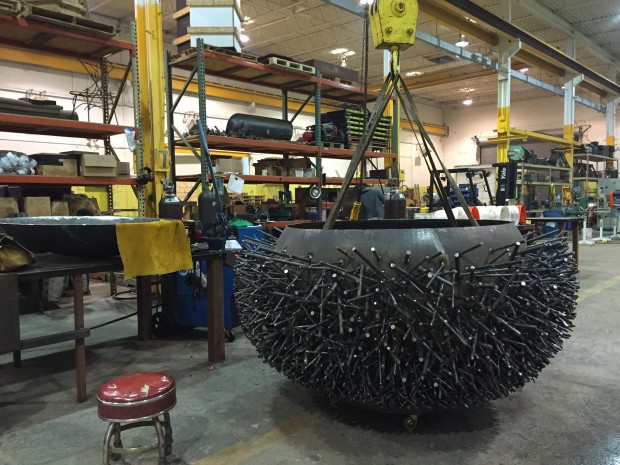 Branch created this fountain for the garden strictly on speculation. Why would I speculate? All of the Branch fabricators, and the studio head, Buck, are very creative people. They need a project once in a while that allows them to stretch their wings, and fabricate something new. This is a breath of fresh air for our group. It creates excitement in the studio. And is is good for a client seeking a very unusual and one of a kind ornament for the garden.
Branch created this fountain for the garden strictly on speculation. Why would I speculate? All of the Branch fabricators, and the studio head, Buck, are very creative people. They need a project once in a while that allows them to stretch their wings, and fabricate something new. This is a breath of fresh air for our group. It creates excitement in the studio. And is is good for a client seeking a very unusual and one of a kind ornament for the garden.
 The Branch group handled the fabrication of this fountain like they were born to make it. Once the stick making had covered the surface, a decision was made to leave the 6″ wide return plain. The contrast of one complex surface to the other plain one is striking and pleasing. The fountain jet will be fabricated next. The jet pipe will mimic the spherical shape and construction of the fountain. Water from the jet pipe splashing over a rod steel covered sphere will be quite musical. The sound of a fountain is a considerable part of its attraction.
The Branch group handled the fabrication of this fountain like they were born to make it. Once the stick making had covered the surface, a decision was made to leave the 6″ wide return plain. The contrast of one complex surface to the other plain one is striking and pleasing. The fountain jet will be fabricated next. The jet pipe will mimic the spherical shape and construction of the fountain. Water from the jet pipe splashing over a rod steel covered sphere will be quite musical. The sound of a fountain is a considerable part of its attraction.
 Clients considering the purchase of Branch containers are concerned about the longevity, and the durability of their resistance to rust, and rightfully so. Everything we manufacture is meticulously hand fabricated with heavy gauge hot rolled steel, with a lifetime of service in mind. The cost of them reflects this. What we do to prevent rust is considerable. All of our containers, fountains, and garden ornament are sent out for galvanizing after it is fabricated. Our galvanizing company has a zinc tank 6 feet wide, 8 feet deep, and forty feet long. This shape has everything to do with the fact that most steel that comes here for galvanizing are steel beams using in the construction of building, bridges, and so on. The plant manager was dubious the day we arrived with our first load of garden containers. 13 years later they know we are as serious about rust prevention as we are about beauty. We pay for galvanizing by the pound. Our scale at Branch only weighs objects up to 2000 pounds. This fountain went over the 2000 pound mark. We won’t know what it weighs until after the galvanizing is complete. The fountain is lifted with a bridge crane via steel straps in preparation for the dip.
Clients considering the purchase of Branch containers are concerned about the longevity, and the durability of their resistance to rust, and rightfully so. Everything we manufacture is meticulously hand fabricated with heavy gauge hot rolled steel, with a lifetime of service in mind. The cost of them reflects this. What we do to prevent rust is considerable. All of our containers, fountains, and garden ornament are sent out for galvanizing after it is fabricated. Our galvanizing company has a zinc tank 6 feet wide, 8 feet deep, and forty feet long. This shape has everything to do with the fact that most steel that comes here for galvanizing are steel beams using in the construction of building, bridges, and so on. The plant manager was dubious the day we arrived with our first load of garden containers. 13 years later they know we are as serious about rust prevention as we are about beauty. We pay for galvanizing by the pound. Our scale at Branch only weighs objects up to 2000 pounds. This fountain went over the 2000 pound mark. We won’t know what it weighs until after the galvanizing is complete. The fountain is lifted with a bridge crane via steel straps in preparation for the dip.
 This tank holds 824,000 pounds of molten zinc, heated to about 900 degrees. The galvanization process completely immerses the raw steel object in molten zinc, very slowly. The shock of the heat to the steel is considerable. Steel which is not thick enough can be damaged by the plating process. The molten zinc coats every surface with a skin of zinc. How much of a skin? This fountain will weigh 20% more once it is galvanized. This means that a 3000 pound object will emerge with 500 pounds of zinc coating its surface.The fountain was lowered into the tank ever so slowly.
This tank holds 824,000 pounds of molten zinc, heated to about 900 degrees. The galvanization process completely immerses the raw steel object in molten zinc, very slowly. The shock of the heat to the steel is considerable. Steel which is not thick enough can be damaged by the plating process. The molten zinc coats every surface with a skin of zinc. How much of a skin? This fountain will weigh 20% more once it is galvanized. This means that a 3000 pound object will emerge with 500 pounds of zinc coating its surface.The fountain was lowered into the tank ever so slowly.
 The shop foreman made a trip up to Branch to inspect what we had a mind to galvanize, before we took the fountain to them. An object of this size and complexity is a once a year project for us. There are logistical issues that need to be addressed in advance. There was plenty of discussion about what it would take to get the fountain to sink slowly and evenly. An object that floats on top of the molten zinc is a problem object. Our big spherical fountain had lots of holes drilled in it, which will be repaired with galvanized steel discs once the galvanizing process is complete. Our garden boxes have loose galvanized plate steel bottoms which are added after the boxes are galvanized. A box with no bottom sinks in the zinc bath.
The shop foreman made a trip up to Branch to inspect what we had a mind to galvanize, before we took the fountain to them. An object of this size and complexity is a once a year project for us. There are logistical issues that need to be addressed in advance. There was plenty of discussion about what it would take to get the fountain to sink slowly and evenly. An object that floats on top of the molten zinc is a problem object. Our big spherical fountain had lots of holes drilled in it, which will be repaired with galvanized steel discs once the galvanizing process is complete. Our garden boxes have loose galvanized plate steel bottoms which are added after the boxes are galvanized. A box with no bottom sinks in the zinc bath.
 The fountain took as long to emerge as it did to descend.
The fountain took as long to emerge as it did to descend.
 A molten zinc tank always has floating hardened zinc and impurities floating on the surface. Prior to and during the galvanizing of this fountain, the surface of the molten zinc got raked, so those impurities would not be deposited on the surface. Occasionally a glob of something will stick to an object. If it is chipped off, or ground down too hard, the integrity of the galvanizing might be breached.
A molten zinc tank always has floating hardened zinc and impurities floating on the surface. Prior to and during the galvanizing of this fountain, the surface of the molten zinc got raked, so those impurities would not be deposited on the surface. Occasionally a glob of something will stick to an object. If it is chipped off, or ground down too hard, the integrity of the galvanizing might be breached.
 If a galvanized object from us develops a small rust spot, it will do so within 2 weeks of being outdoors. That spot can be repaired with cold galvanizing compound. A breach in the galvanizing is a rare occurrence.
If a galvanized object from us develops a small rust spot, it will do so within 2 weeks of being outdoors. That spot can be repaired with cold galvanizing compound. A breach in the galvanizing is a rare occurrence.
 The moment any steel object emerges from a zinc bath sports a shiny as silver color. Once that object comes in contact with the air, that shiny surface begins to oxidize, and will become that dull gray color one usually associates with galvanized metal.
The moment any steel object emerges from a zinc bath sports a shiny as silver color. Once that object comes in contact with the air, that shiny surface begins to oxidize, and will become that dull gray color one usually associates with galvanized metal.
 The process by which Branch fabricates, finishes, and sells their garden pots, fountains, pergolas and ornament is all about beautiful design and fabrication, and a thoughtful and serious finish that is unlikely to need any maintenance. My thanks to the plant manager for taking these pictures for me.
The process by which Branch fabricates, finishes, and sells their garden pots, fountains, pergolas and ornament is all about beautiful design and fabrication, and a thoughtful and serious finish that is unlikely to need any maintenance. My thanks to the plant manager for taking these pictures for me.
 Back at Branch, the fountain is awaiting our final signature finish, which will give the steel that blue gray patina which is reminiscent of lead. Heather, who handles all of the Branch Studio inquiries, came with me for a look see today.
Back at Branch, the fountain is awaiting our final signature finish, which will give the steel that blue gray patina which is reminiscent of lead. Heather, who handles all of the Branch Studio inquiries, came with me for a look see today.

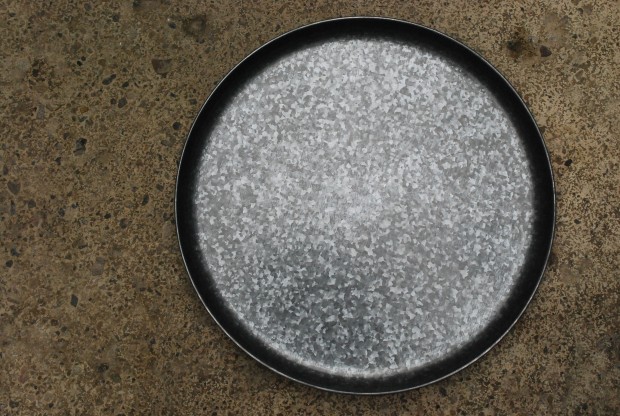



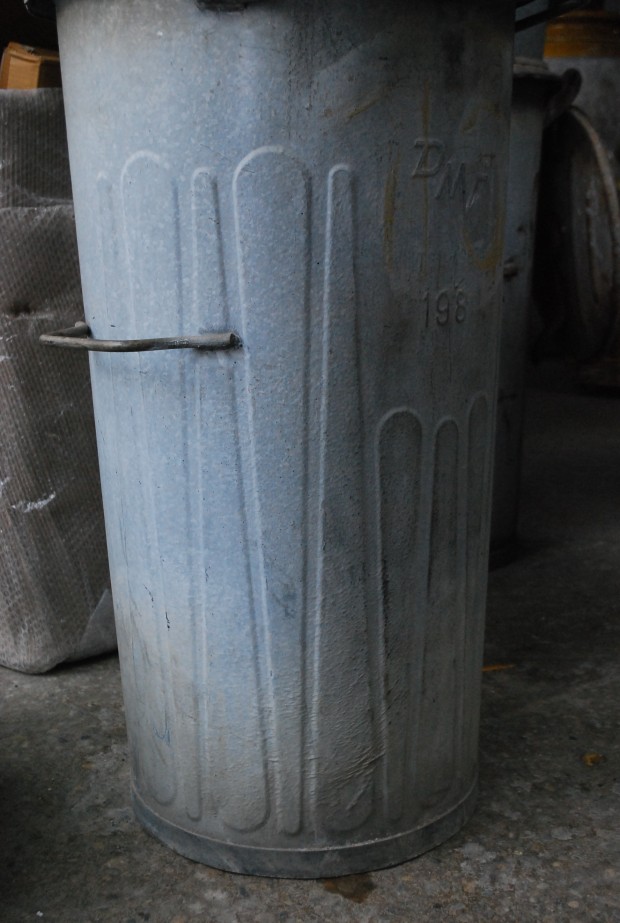
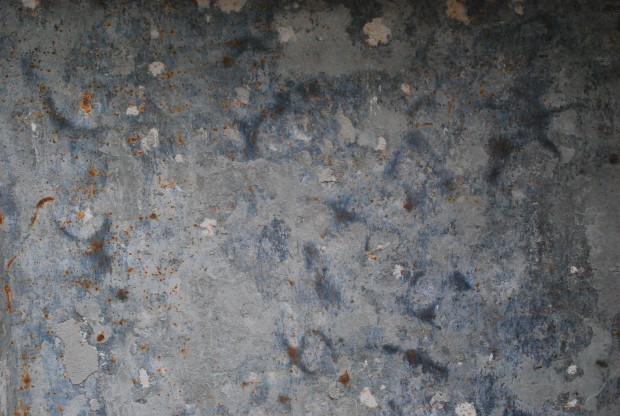



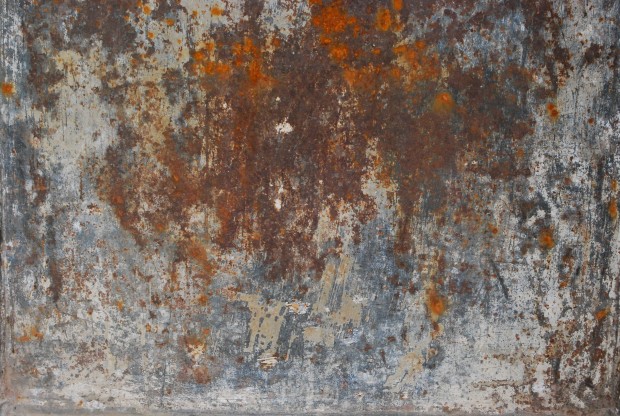


![Containers421[1] Containers421[1]](https://deborahsilver.com/wp-content/uploads/2010/02/Containers4211.jpg) Galvanized buckets and troughs have graced many a barn and farm garden. It’s no stretch to plant them with vegetables, flowers or herbs. My favorite pot compositions of Rob’s are his “roadside weed” plantings. Loose, grassy and verging on scraggly, they are charmingly natural and unstudied. A bucket is a perfect container. A sizeable pail can be an unexpectedly handsome home for a lotus. My brother had a garden party once (Petey most assuredly is not a gardener)-he used a number of large pails as burn buckets once the light started fading. I must admit it looked great-his casual grouping of fires in buckets.
Galvanized buckets and troughs have graced many a barn and farm garden. It’s no stretch to plant them with vegetables, flowers or herbs. My favorite pot compositions of Rob’s are his “roadside weed” plantings. Loose, grassy and verging on scraggly, they are charmingly natural and unstudied. A bucket is a perfect container. A sizeable pail can be an unexpectedly handsome home for a lotus. My brother had a garden party once (Petey most assuredly is not a gardener)-he used a number of large pails as burn buckets once the light started fading. I must admit it looked great-his casual grouping of fires in buckets. ![C1191[1] C1191[1]](https://deborahsilver.com/wp-content/uploads/2010/02/C11911.jpg) This large galvanized steel cistern is English in origin. The pitted, highly textured surface is indicative of some age. A tomato garden with herbs would be smashing. It would be equally as attractive as a fountain. It is also the perfect height to accomodate a large thick stone top-a perfect dining table base for a contemporary garden. Galvanized metal is a chamaeleon garden material-it seems to adapt and make itself at home in a variety of settings.
This large galvanized steel cistern is English in origin. The pitted, highly textured surface is indicative of some age. A tomato garden with herbs would be smashing. It would be equally as attractive as a fountain. It is also the perfect height to accomodate a large thick stone top-a perfect dining table base for a contemporary garden. Galvanized metal is a chamaeleon garden material-it seems to adapt and make itself at home in a variety of settings.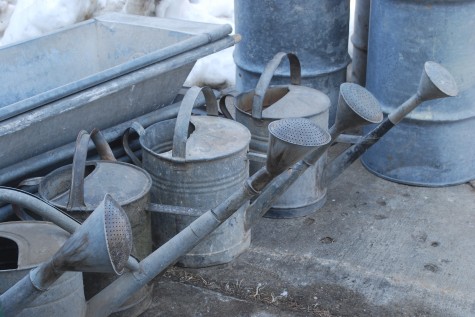
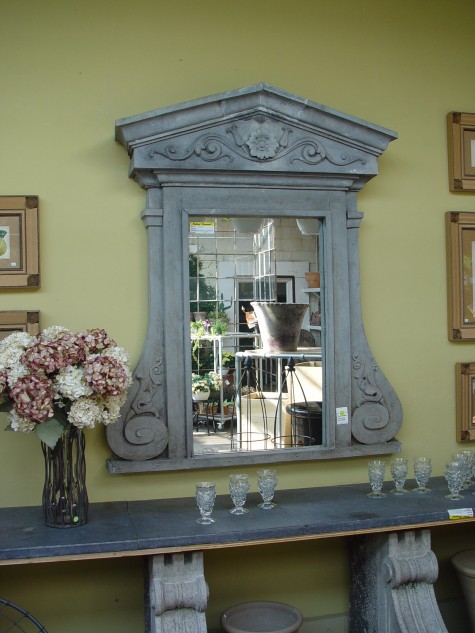

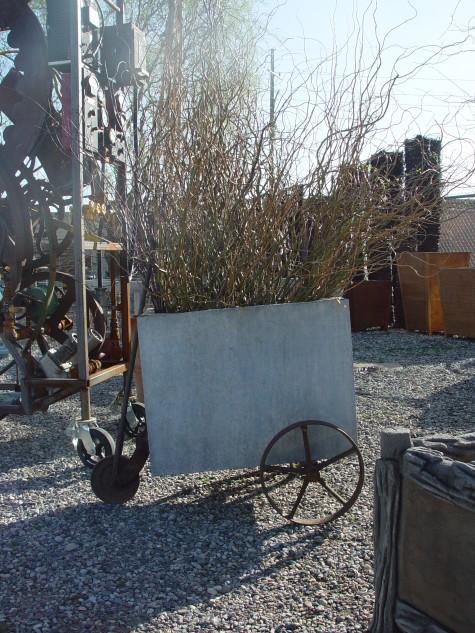 This old French water cart would be my nemesis-I cannot imagine filling it with water, and hauling it to the garden, many times over. But parked in one spot, I could come to appreciate its form, and its history. Not everyone loves classical garden sculpture; it’s a good thing they don’t need to. Though it would not be my choice, I have seen gardens where vintage tools are displayed as sculpture to beautiful effect.
This old French water cart would be my nemesis-I cannot imagine filling it with water, and hauling it to the garden, many times over. But parked in one spot, I could come to appreciate its form, and its history. Not everyone loves classical garden sculpture; it’s a good thing they don’t need to. Though it would not be my choice, I have seen gardens where vintage tools are displayed as sculpture to beautiful effect. 
